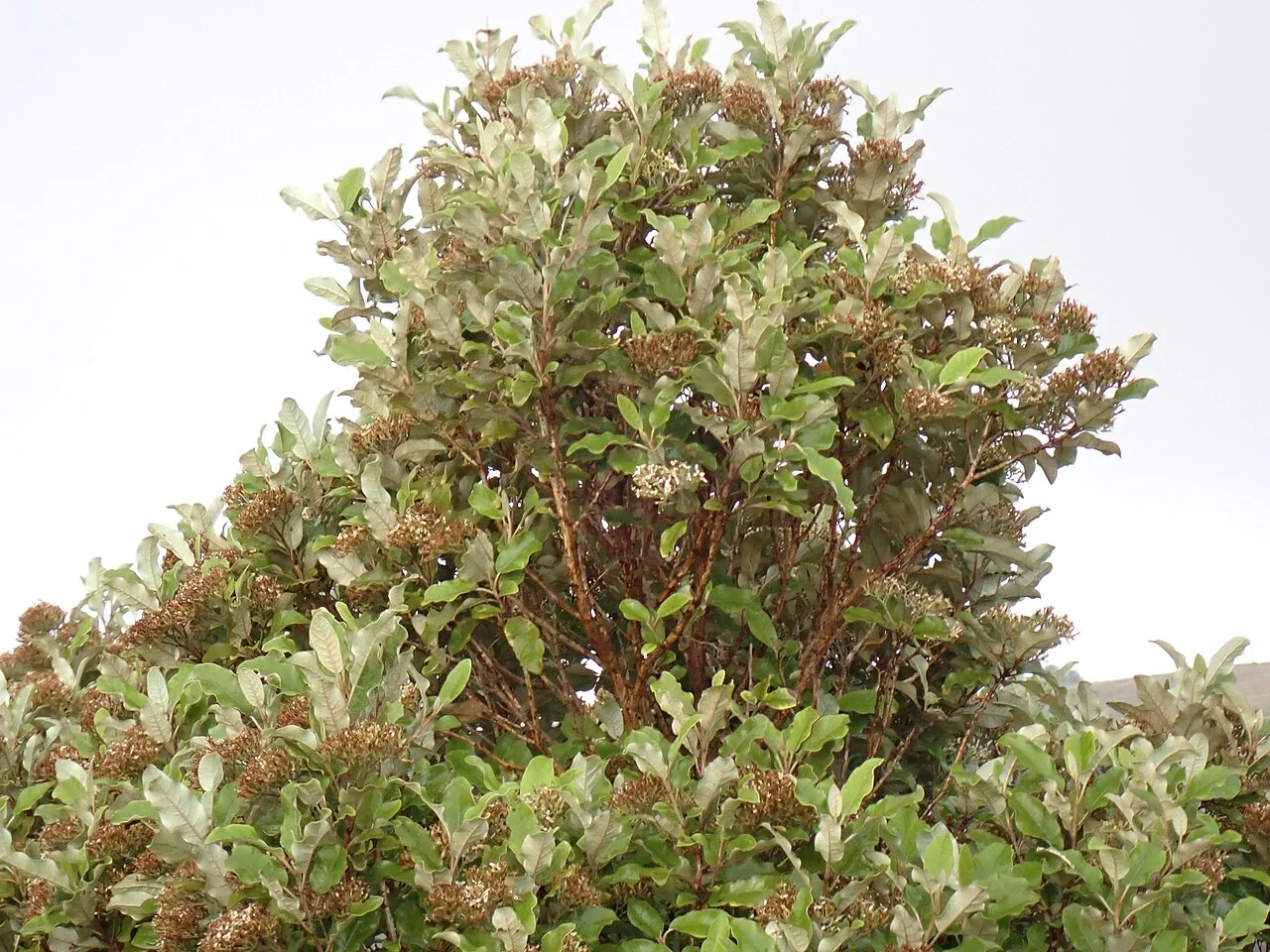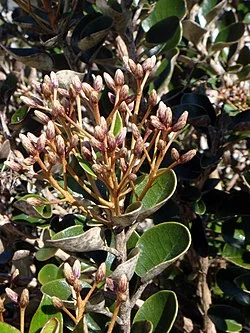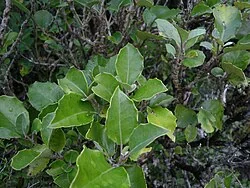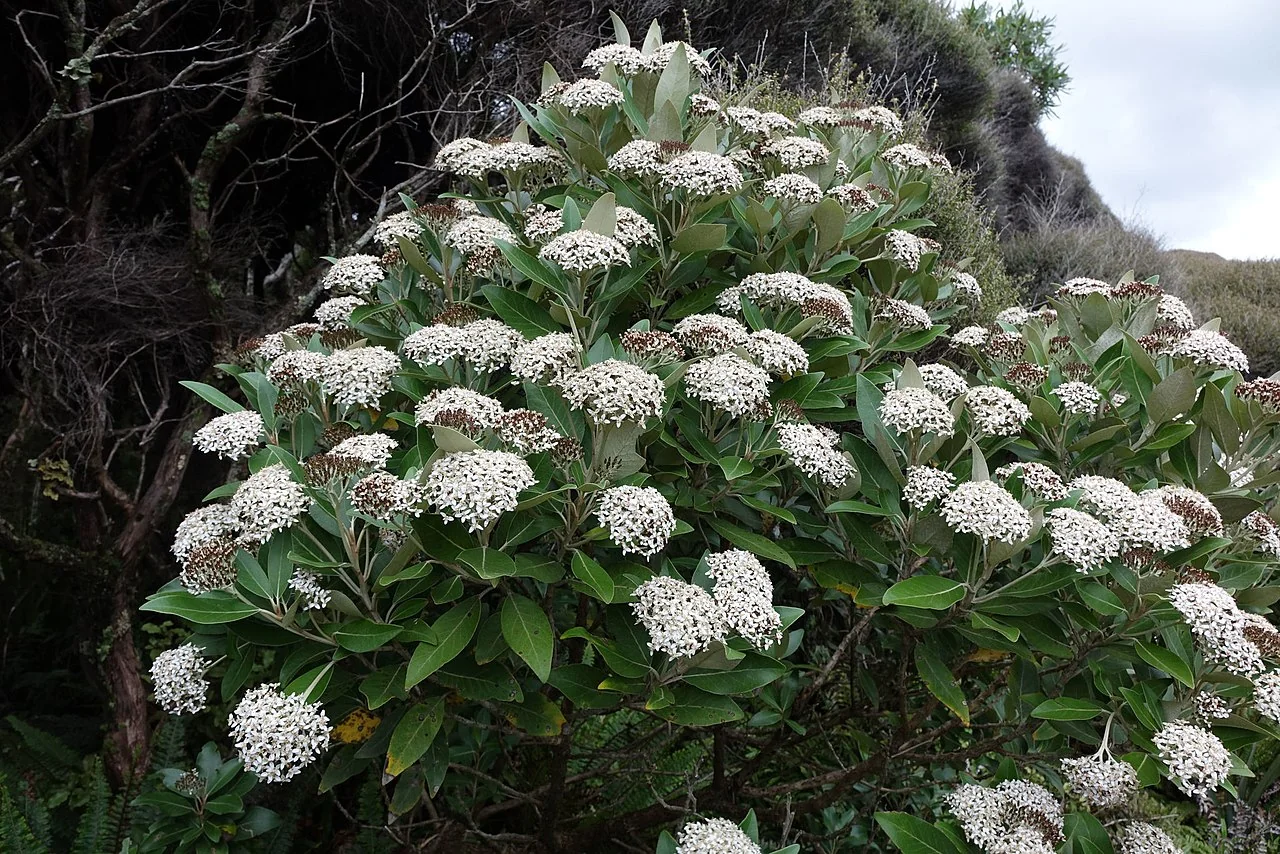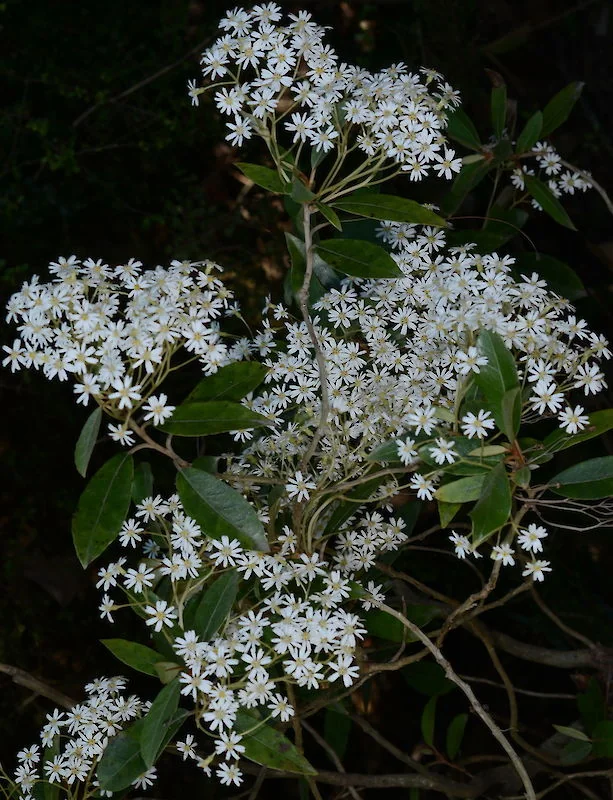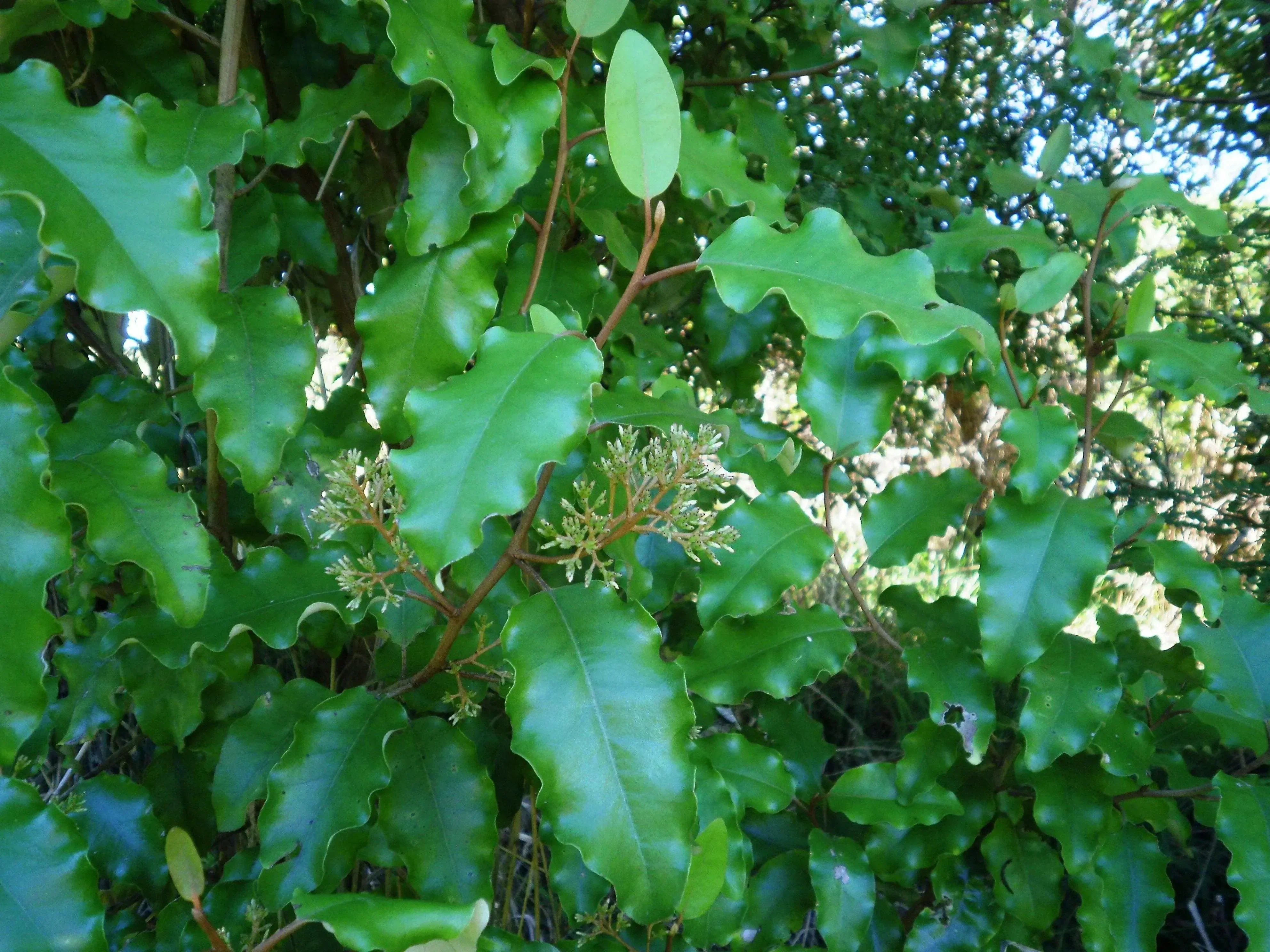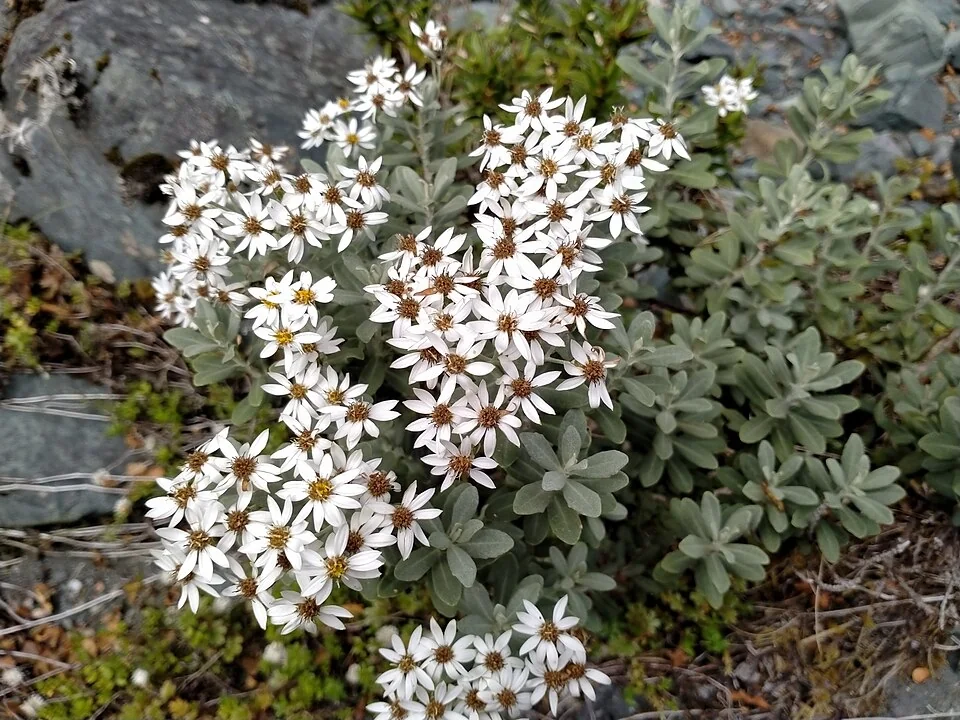
Musky Tree Daisy
Olearia moschata
Musky Tree Daisy (scientific name: Olearia moschata ) Musky Tree Daisy is a native tree daisy that produces masses of small white or cream flowers. Like other Olearia species, it's valued for its hardy nature and ability to provide shelter and nectar for native wildlife. Explore more in the native plants index .

Plant Description
Botanical Features
Musky Akeake and Place
Musky Tree Daisy ( Olearia moschata ) carries a faint scent on warm days and forms silver‑backed leaves that catch the light in tussock and scrub. While specific traditional uses are not widely cited, akeake as a group supplied tough timber and shelter around kāinga. Contemporary restoration in high‑country stations and reserves uses O. moschata to rebuild grey shrublands, supporting pollinators and buffering harsher alpine winds along tracks and fence lines.
Musky Tree Daisy ( Olearia moschata ), also known as incense plant, is a broadleaf evergreen shrub native to the South Island of New Zealand. It typically grows to about 3 to 6 feet (approximately 1 to 2 meters) tall and wide, with a dense, bushy, and much-branched habit. Its small, leathery leaves are oval to obovate, ranging from 8-15 mm long, and are often covered with a soft white, appressed tomentum (dense, matted hairs) on the undersides, and sometimes on both surfaces when young. The entire plant can be a pale grey colour, providing a good contrast with other plants. A notable feature is its musky fragrance, especially when the leaves are crushed. In summer, it produces small white daisy-like flowers, often with yellow centers, which emerge in clusters (corymbs). These flowers can be so abundant that they almost hide the leaves.
Quick Facts
Overview
| Scientific Name | Olearia Moschata |
|---|---|
| Height | 2-6 m |
| Spread | 2-4 m |
| Water Needs | Low to moderate |
| Light | Full sun to partial shade |
| Frost Tolerance | Moderate to good |
| Salt Tolerance | Moderate |
| Growth Rate | Moderate |
| Lifespan | Long-lived |
Climate Best Suited to
Regional climate suitability across major New Zealand cities.
Regional Suitability
| Whangārei | Ideal |
| Auckland | Ideal |
| Hamilton | Suitable |
| Rotorua | Suitable |
| Tauranga | Ideal |
| Gisborne | Ideal |
| New Plymouth | Ideal |
| Whanganui | Ideal |
| Palmerston North | Suitable |
| Napier | Ideal |
| Wellington | Ideal |
| Nelson | Ideal |
| Christchurch | Suitable |
| Dunedin | Suitable |
| Invercargill | Suitable |
| City | Climate Suitability |
|---|
Natural Habitat
Musky Tree Daisy is native to New Zealand, where it thrives in alpine and subalpine regions of the South Island, particularly south from Arthur's Pass. It is adapted to rocky soils and cold, windy conditions, exhibiting resilience in harsh climates due to its compact growth and leathery foliage. It prefers full sun and well-drained soil.
Conservation
Plant Conservation
Olearia moschata , commonly known as the musky tree daisy, is a native and endemic vascular plant to New Zealand. As of 2023, its conservation status is classified as "Not Threatened" by the NZPCN. This status has remained consistent in previous assessments from 2017, 2012, 2009, and 2004. This greyish shrub is characterized by its musky-smelling, grey-green oval leaves and white flowers with a yellow centre. It thrives in subalpine regions south of Arthur's Pass, adapting to rocky soils and harsh, windy conditions.
Growing Requirements
Soil Requirements
Alpine/subalpine species preferring gritty, free-draining soils; avoid waterlogging.
Light Requirements
Full sun; tolerates frost and exposure.
Water Requirements
Low; water to establish, then sparingly.
Planting Guide
1. Site Selection:
- Sunlight: Choose a location that receives full sun to partial shade. Olearia moschata requires at least 6 hours of direct sunlight daily, though some protection from the harshest afternoon sun can prevent leaf burn.
- Soil: Ensure the planting site has well-drained soil. The plant is adapted to rocky soils and does not tolerate waterlogging.
- Hardiness: Olearia moschata is cold hardy to USDA Zone 8a (around 10°F). In colder climates, it may require winter shelter.
2. When to Plant:
The ideal time for transplanting Olearia moschata is in early spring, as the weather begins to warm after winter. This allows the plant to establish robust growth and acclimate to its new environment.
Ecological Role
Environmental Benefits
Musky tree daisy ( Olearia moschata ) is a subalpine to alpine shrub that weaves into open scrub and fellfield margins. Summer flowering provides seasonal nectar and pollen pulses for high‑country insects; its low, wind‑shorn form creates lee‑side refuges for invertebrates and protects shallow soils from frost‑heave and scouring winds.
- Alpine resource: Daisy heads support pollinators during brief alpine summers.
- Wind buffering: Cushioned canopies slow wind and trap fine litter.
- Surface stability: Roots help bind skeletal soils on ridges and frost flats.
Uses and Significance
Alpine Garden Applications
Olearia moschata is exceptional for high-country and rock gardens due to its compact, dense growth habit and distinctive musky-scented foliage. This evergreen shrub's resilience to rocky soils and harsh alpine conditions makes it perfect for challenging landscape situations where other plants struggle. Its distinctive musk-like fragrance adds a unique sensory element to native plant collections.
Ecological and Ornamental Value
The clusters of white daisy-like flowers with yellow centres provide valuable pollinator support in alpine environments where flowering plants are scarce. This tough shrub's ability to thrive in dry and windy conditions makes it particularly useful for shelter and establishing plants in difficult mountain situations, while contributing to New Zealand's unique alpine flora biodiversity.
Cultural Importance
Aromatic Heritage
The musky fragrance of Olearia moschata gives it a niche role in sensory gardens and regional plant displays, where alpine shrubs are celebrated for scent and resilience.
Cultural Significance
Olearia moschata , also known as the Musky Tree Daisy or incense plant, is a broadleaf evergreen shrub native to the alpine regions of New Zealand. While it has distinctive characteristics like musky-scented leaves and white daisy-like flowers, the search results do not indicate significant cultural uses or traditional significance beyond its natural properties.
It is noted for its aromatic leaves, which have a mild musky fragrance, and its resilience in cold, windy conditions and rocky soils. It is sometimes referred to as "Incense Plant" due to this musky scent. One source mentions "Traditional uses" as a category but lists "Fragrance musk scented" under it, indicating its scent is its primary traditional use, rather than medicinal or other cultural practices. It is not listed as having medicinal uses, edible parts, or being poisonous.
Landscaping Ideas
Musky Tree Daisy ( Olearia moschata ) is an exceptional native shrub that brings unique sensory appeal and distinctive character to New Zealand landscaping projects. This remarkable subalpine specialist offers outstanding aromatic qualities, silvery-grey foliage, and exceptional hardiness that makes it particularly valuable for challenging alpine sites and specialized garden applications where few other plants can thrive.
Alpine and Rock Garden Excellence
- Authentic subalpine landscapes: Essential component for creating authentic New Zealand alpine environments, naturally adapted to rocky soils, cold temperatures, and windy conditions found at elevations from 900-1500 meters.
- Rock garden centerpieces: Compact, dense growth habit reaching 3-6 feet makes it perfect for large rock gardens where its silvery-grey foliage and musky fragrance create distinctive focal points among alpine stone arrangements.
- Alpine plant collections: Prized addition to specialist alpine gardens and high-elevation botanical collections, representing authentic New Zealand subalpine flora with unique characteristics rarely found in cultivation.
- Mountain property landscaping: Outstanding choice for high-elevation residential properties where extreme weather conditions require exceptionally hardy plant selections that can withstand frost, wind, and temperature variations.
Sensory and Aromatic Garden Applications
- Scented garden features: Distinctive musky fragrance released when leaves are brushed or crushed makes it excellent for pathways, seating areas, and interactive garden spaces where visitors can experience its unique aromatic qualities.
- Therapeutic and healing gardens: Aromatic properties and tactile foliage provide sensory stimulation valuable for therapeutic garden settings, meditation spaces, and wellness landscapes where natural fragrances promote relaxation.
- Children's discovery gardens: Fascinating musky scent and soft-textured foliage engage children's senses, making it excellent for educational gardens where young visitors can safely explore plant characteristics.
- Moonlight and evening gardens: Silvery-grey foliage reflects moonlight beautifully, while the subtle musky fragrance adds another dimension to nighttime garden experiences.
Foliage and Textural Design
- Silver foliage contrasts: Distinctive silvery-grey coloration provides striking contrast against darker-leaved companions, creating sophisticated colour schemes and highlighting the subtle beauty of native plant palettes.
- Compact architectural specimens: Dense, bushy, much-branched habit creates natural architectural forms that require minimal pruning while maintaining attractive compact shapes throughout the year.
- Seasonal flower displays: Abundant white daisy flowers with yellow centers nearly hide the foliage during peak blooming, creating spectacular spring and summer displays that transform the plant's appearance.
- Textural diversity plantings: Small, aromatic leaves offer fine texture that contrasts beautifully with broad-leaved or coarse-textured companions in mixed native plantings.
Challenging Site Solutions
- Windbreak establishment: Exceptionally tough and wind-hardy nature makes it valuable for creating protective barriers on exposed sites, ridgelines, and areas subject to constant wind pressure.
- Drought-resistant landscaping: Once established, tolerates dry conditions exceptionally well, making it perfect for water-wise gardens and xeriscaping projects in areas with limited irrigation.
- Poor soil adaptation: Thrives in rocky, gravelly, or nutrient-poor soils where many other plants struggle, providing reliable performance on challenging sites with minimal soil preparation.
- Slope stabilization: Dense root systems help prevent erosion on steep banks and slopes while providing attractive year-round coverage that requires minimal maintenance.
Specialized Garden Themes
- Native plant conservation: Important for conservation-focused landscapes that preserve and display New Zealand's endemic subalpine flora, contributing to biodiversity preservation and education efforts.
- Botanical and educational gardens: Excellent for demonstration gardens where its distinctive characteristics illustrate subalpine plant adaptations and the diversity of New Zealand's endemic tree daisy family.
- Revegetation and restoration: Valuable for ecological restoration projects in subalpine zones, helping to recreate natural plant communities and provide habitat for native species adapted to high-elevation environments.
- Specialist collections: Highly valued by collectors of unusual native plants and alpine specialists, offering unique characteristics and challenging cultivation that appeals to dedicated gardeners.
Wildlife and Ecological Benefits
- Pollinator support: Abundant white flowers provide crucial nectar resources for native bees and other pollinators during spring and summer blooming periods when alpine flowers may be scarce.
- Habitat structure: Dense branching provides excellent shelter and nesting opportunities for small birds and beneficial insects throughout the year, contributing to alpine ecosystem diversity.
- Seed head value: Attractive fluffy seed heads provide food for seed-eating birds while adding ornamental interest during autumn and winter months.
- Ecosystem restoration: Supports native biodiversity by providing authentic habitat structure and food resources that encourage native wildlife establishment in restored or created alpine environments.
Practical Landscaping Advantages
- Low maintenance requirements: Once established, requires minimal care beyond occasional light pruning, making it ideal for low-maintenance landscapes and areas with limited ongoing garden management.
- Climate resilience: Outstanding tolerance for extreme weather conditions including frost, wind, and drought makes it reliable in unpredictable mountain climates where plant survival is challenging.
- Year-round appeal: Evergreen nature ensures consistent landscape value through all seasons, with silvery foliage providing winter interest and abundant spring flowers creating seasonal highlights.
- Natural form maintenance: Develops attractive compact shape without extensive pruning, naturally maintaining proportions that never become overwhelming or unmanageable in garden settings.
Design Integration and Companion Planting
- Subalpine plant communities: Pairs excellently with other mountain natives like Hebe, Dracophyllum, and Celmisia species for authentic high-elevation ecosystem recreation and natural plant associations.
- Contrast combinations: Silvery-grey foliage creates stunning contrasts with dark green or burgundy-leaved companions, enhancing overall garden composition and visual interest.
- Seasonal plant partnerships: Provides evergreen structure for gardens featuring alpine bulbs, seasonal perennials, or deciduous mountain species that require permanent backdrop plantings.
- Hedging and mass plantings: Excellent for informal hedging and mass plantings where consistent height, texture, and colour create unified landscape effects with authentic New Zealand character.
Seasonal Care Calendar
Spring
Plant new specimens or divide established clumps; perform light formative pruning to shape and encourage new growth in preparation for the flowering season.
Summer
Requires minimal watering due to its drought tolerance; avoid rich fertilizers, as this alpine species thrives in leaner conditions.
Autumn
Lightly shape the plant after flowering has concluded to maintain its compact form and remove any spent blooms, ensuring a tidy appearance.
Winter
This hardy plant tolerates cold well; ensure excellent drainage, especially in areas prone to heavy winter moisture, to prevent root issues.
Pruning and Maintenance
Techniques and Timing
Musky tree daisy naturally maintains a dense, bushy, much-branched habit that requires minimal intervention. Light clipping after flowering helps preserve the compact alpine form and encourages continued dense growth. Avoid heavy pruning as this alpine species prefers gentle maintenance to maintain its characteristic tight growth pattern. The aromatic foliage releases its distinctive musky scent when handled, making pruning a sensory experience unique to this species.
How to Grow Musky Tree Daisy
Musky Tree Daisy is a distinctive subalpine shrub with aromatic foliage, a silvery-grey appearance, and white daisy flowers. This South Island endemic is highly valued for its unique musky scent and its ability to thrive in challenging, exposed alpine environments. It is an excellent choice for specialized native plant gardens, rockeries, or as a specimen plant where its unique growth habit can be appreciated. Understanding its propagation methods is key to successfully growing this important species and contributing to its conservation.
From Cuttings
Semi-hardwood cuttings can be taken from healthy shoots, though this alpine species may be more challenging to propagate than lowland Olearia species. Use rooting hormone and maintain consistent humidity while providing protection from temperature extremes. Take cuttings from non-flowering shoots for best results, handling carefully to preserve the aromatic qualities. This method is crucial for conservation efforts as it preserves the genetic material of specific populations of this unique alpine plant.
From Seed
Propagating Musky Tree Daisy from seed is a viable method, though it requires fresh seeds and careful attention to conditions. The fluffy seeds can be surface-sown on a well-draining alpine mix, though viability may be variable. Keep soil consistently moist but not waterlogged, providing protection from harsh conditions. This species is not commonly in cultivation, making seed collection from wild plants important for conservation propagation efforts in specialized alpine plant collections. This method is crucial for maintaining genetic diversity and for large-scale restoration projects.
Pests and Diseases
Musky Tree Daisy ( Olearia moschata ) is generally a remarkably resilient subalpine native that experiences relatively few serious pest or disease problems when grown in appropriate conditions. Its natural adaptation to harsh subalpine environments, including exposure to frost, drought, and extreme weather conditions, contributes to its overall robust constitution and natural resistance to many common cultivation issues.
Environmental Stress Challenges
- Climate sensitivity: While hardy in appropriate subalpine conditions, may struggle in climates that are too hot, humid, or consistently wet. Requires cool climate conditions and dislikes hot or humid environments that differ significantly from its natural mountain habitat.
- Drainage requirements: Essential to provide excellent drainage as waterlogged conditions can quickly lead to root problems and plant decline. This species is naturally adapted to well-draining rocky soils and cannot tolerate prolonged wet conditions.
- Drought stress vulnerability: Despite its alpine origins, young plants do not tolerate complete drying out and require consistent moisture during establishment. Extended drought stress can cause leaf browning and reduced vigor.
- Heat stress problems: Particularly sensitive to excessive heat, especially when combined with humidity. High temperatures can cause sudden decline and stress that predisposes plants to secondary problems.
Cultivation-Specific Challenges
- Propagation difficulties: Like other subalpine Olearia species, cutting propagation can be variable in success rate, with best results obtained from cuttings taken after active growth and kept in cool, humid conditions through winter.
- Establishment stress: Young plants are particularly vulnerable during their first few seasons and require careful monitoring and protection from environmental extremes during the critical establishment period.
- Site requirement specificity: Requires specific microclimate conditions including cool, moist air and protection from extreme temperature fluctuations. Failure to provide appropriate conditions leads to chronic stress and poor performance.
- Soil chemistry sensitivity: Performs best in humus-enriched soils with specific drainage characteristics. Poor or depleted soils can lead to nutrient deficiencies and increased vulnerability to environmental stress.
Disease Resistance and Prevention
- Fungal disease susceptibility: In overly wet conditions, may occasionally develop fungal diseases similar to other alpine daisies. Ensuring excellent drainage and good air circulation prevents most fungal problems.
- Root rot prevention: The most critical aspect of maintaining healthy plants is preventing waterlogged conditions that lead to root rot. Plant in raised beds or well-draining sites to avoid water accumulation.
- Secondary infection risks: Plants weakened by environmental stress become more susceptible to opportunistic fungal or bacterial infections. Maintaining optimal growing conditions is the best preventive approach.
- Crown rot issues: Poor drainage around the crown can lead to rot problems, particularly during wet winters. Ensure planting sites have excellent surface drainage and avoid mulching too close to plant stems.
Pest Management
- General pest resistance: Natural subalpine adaptation provides excellent resistance to most common garden pests, though some monitoring during growing seasons is beneficial.
- Herbivorous insect damage: Like related alpine daisies, may occasionally experience leaf damage from caterpillars or other herbivorous insects, though significant infestations are rare due to its natural habitat adaptation.
- Scale insect problems: May occasionally be affected by scale insects, particularly in sheltered garden situations that differ from its natural exposed habitat. Monitor regularly and treat with horticultural oil if needed.
- Browsing animal damage: Young plants may be vulnerable to browsing by introduced animals such as rabbits or possums. Protection with appropriate barriers may be necessary until plants are well-established.
Integrated Environmental Management
- Microclimate creation: Focus on creating appropriate subalpine microclimates rather than reactive pest and disease control. Success depends on replicating natural environmental conditions including cool, moist air and excellent drainage.
- Site preparation: Prepare planting sites with slightly raised beds of well-cultivated soil to ensure drainage that provides near-surface roots with aerated growing conditions.
- Moisture management: Maintain consistent soil moisture without waterlogging, using appropriate mulching to conserve moisture while ensuring surface drainage prevents crown problems.
- Air circulation: Ensure good air movement around plants to prevent humid conditions that might encourage fungal development while avoiding excessive wind exposure.
Seasonal Health Monitoring
- Spring establishment care: Monitor young plants closely during spring growth periods when they are most vulnerable to environmental stress and establishment challenges.
- Summer stress management: Watch for signs of heat or drought stress during summer months, providing additional protection or irrigation if necessary to maintain plant health.
- Winter protection: Ensure excellent drainage during winter months when wet conditions combined with cold temperatures can create conditions favorable for root problems.
- Year-round observation: Regular monitoring for changes in foliage colour, growth patterns, or overall vigor helps identify environmental stress before serious problems develop.
Long-Term Health Strategies
- Habitat maintenance: Focus on maintaining optimal subalpine growing conditions rather than treating individual problems. Healthy plants in appropriate conditions rarely experience serious pest or disease issues.
- Companion plant support: Use appropriate companion plantings to create supportive microclimates and beneficial growing conditions that enhance natural resistance to problems.
- Stress prevention: Proactive environmental management prevents most health issues. Address site drainage, air circulation, and moisture management before problems occur.
- Natural resilience support: Work with the plant's natural subalpine adaptations rather than against them, providing conditions that allow its inherent hardiness to provide protection against pests and diseases.
Successful cultivation of Musky Tree Daisy relies primarily on understanding and providing appropriate subalpine environmental conditions rather than managing specific pest or disease problems, as this hardy species naturally resists most issues when grown in suitable conditions.
Bonus Tip
Expert Growing Advice
Musky tree daisy ( Olearia moschata ) can be cloud-pruned to highlight its silvery tomentum. Clip lightly after flowering; avoid summer hard-cuts which can shock plants in hot valleys. Gravel mulch reflects light and enhances the plant-s pale colour.
